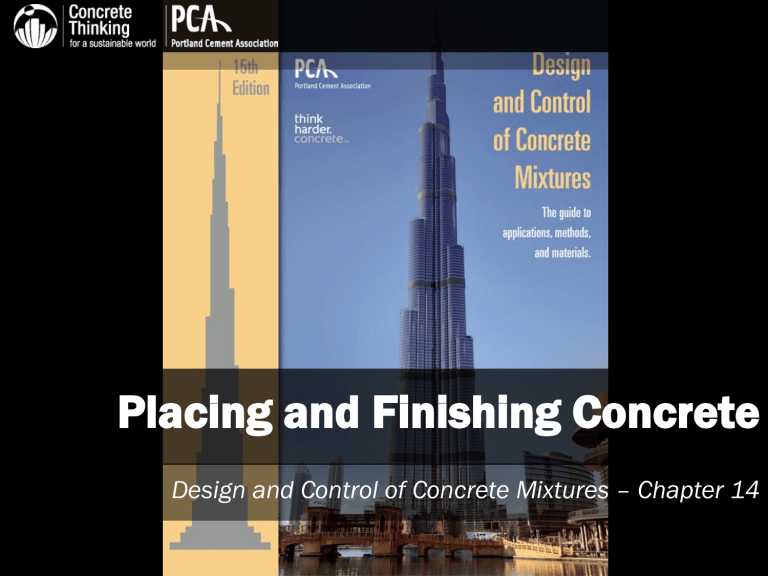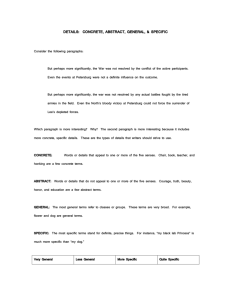Placing and Finishing Concrete

Placing and Finishing Concrete
Design and Control of Concrete Mixtures – Chapter 14
Overview
Preparation before placing
Depositing concrete
Consolidation
Finishing
Jointing
Patching and cleaning concrete
Moisture Control
Moisture Testing
Formwork and Reinforcement
Forms:
Proper alignment, clean, tight, braced
Proper materials for finished look
Reinforcement:
Clean of debris and excessive rust/mill scale
Remove loose, dry mortar from previous lifts
Depositing Concrete
Depositing Concrete
Depositing
Concrete
Placing Concrete Underwater
Placing on Hardened Concrete
Surface must be prepared
Mechanical cleaning, roughening
Walls and columns have weaker tops
Form-cured elements may still have weak tops
Preparing
Hardened
Concrete
Bonding New to Existing Concrete
Special Placing Techniques
Consolidation
Vibration
Vibration
External Vibration
External Vibration
External Vibration
Finishing
Finishes can be customized – colors, textures
Basic steps:
Strikeoff/screeding
Floating
Trowling
Texturing
Timing is important
Screeding/Strikeoff
Process of cutting off excess concrete
Straightedge or screed
Straightedges used in sawing motion
Surcharge of concrete fills low spots
Bullfloating/Darbying
Edging/Jointing
Edging required along edge forms and formed joints in slabs
Densifies concrete where troweling is less effective
First pass before bleeding
Subsequent passes after each finishing operation
Contraction joints can be formed with groovers or inserts
Floating
Troweling
Brooming/Tining
Formed
Surfaces
Special Surface Finishes
Exposed-Aggregate Concrete
Rugged, attractive surface texture
Special aggregates chosen
Embedded by tapping or integrally mixed
Surface mortar is worn away to expose aggregate
Brushing and flushing, may require acid
Abrasive blasting or water blasting
Tooling/bushhammering
Grinding and polishing
Mock-up is necessary
Colored
Finishes
Stain, Paints, and
Clear Coatings
Curing and Protection
Isolation Joints
Contraction Joints
Contraction Joints
Construction
Joints
Horizontal Construction Joints
Horizontal Construction Joints
Joint Layout
Filling Floor Joints
Three options for joints:
Filling
Sealing
Left open
Fillers provide more edge support than sealers
Used for heavy-traffic areas
Unjointed Floors
Three suggested methods:
Post-tensioning
High reinforcement levels
Concrete made with expansive cement
Removing Forms
Ideally forms left on as long as possible
Realistically, forms must come off
Rubbed finishes
Form reuse
Minimum time to form removal based on strength
Forms should be removed gently
Patching and Cleaning Concrete
Bulges, fins, projections chipped off
Undesired metal cut back
Surface can be rubbed
Repairs are easier the younger the concrete
Patches tend to be darker
White cement is used to lighten color
Patching and Cleaning Concrete
Patching and Cleaning Concrete
Curing Patches
Cleaning Concrete Surfaces
Water methods
Low-pressure, moderate- to high-pressure
Steam
Chemical methods
Surfactants
Acids/alkalis
Mechanical methods
Sandblasting, shotblasting, scarification, power chipping, grinding
Precautions
Protect your head and eyes
Full-cover goggles, safety glasses with side shields, NIOSH-approved respirators
Protect your back
Lift with legs, not back
Use mechanical means as much as possible
Working safely with concrete
Wet concrete is caustic and abrasive
Avoid prolonged exposure to skin
Summary
Preparation before placing
Depositing concrete
Consolidation
Finishing
Jointing
Patching and cleaning concrete
Questions







